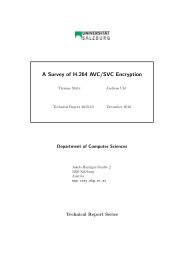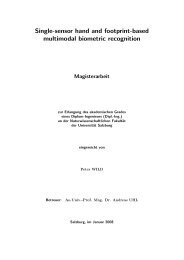Pit Pattern Classification in Colonoscopy using Wavelets - WaveLab
Pit Pattern Classification in Colonoscopy using Wavelets - WaveLab
Pit Pattern Classification in Colonoscopy using Wavelets - WaveLab
You also want an ePaper? Increase the reach of your titles
YUMPU automatically turns print PDFs into web optimized ePapers that Google loves.
1 Introduction<br />
<strong>Pit</strong> pattern type<br />
I<br />
II<br />
III S<br />
III L<br />
IV<br />
V<br />
Characteristics<br />
roundish pits which designate a normal mucosa<br />
stellar or papillary pits<br />
small roundish or tubular pits, which are smaller<br />
than the pits of type I<br />
roundish or tubular pits, which are larger than<br />
the pits of type I<br />
branch-like or gyrus-like pits<br />
non-structured pits<br />
Table 1.1: The characteristics of the different pit pattern types.<br />
To show this, figure 1.3 conta<strong>in</strong>s images out of the tra<strong>in</strong><strong>in</strong>g image set used throughout this<br />
thesis.<br />
(a) <strong>Pit</strong> pattern I (b) <strong>Pit</strong> pattern II (c) <strong>Pit</strong> pattern IIIS<br />
(d) <strong>Pit</strong> pattern IIIL (e) <strong>Pit</strong> pattern IV (f) <strong>Pit</strong> pattern V<br />
Figure 1.3: Images show<strong>in</strong>g the different types of pit pattern.<br />
From these images it is not as easy anymore to tell which type of pit pattern each of these<br />
images represents.<br />
Apart from that it is important to mention that a classification solely based on pit pattern<br />
classification is not possible. There is always a f<strong>in</strong>al histological f<strong>in</strong>d<strong>in</strong>g needed for the<br />
physician to decide whether a lesion <strong>in</strong> a colon is tumorous or non-tumorous.<br />
4








